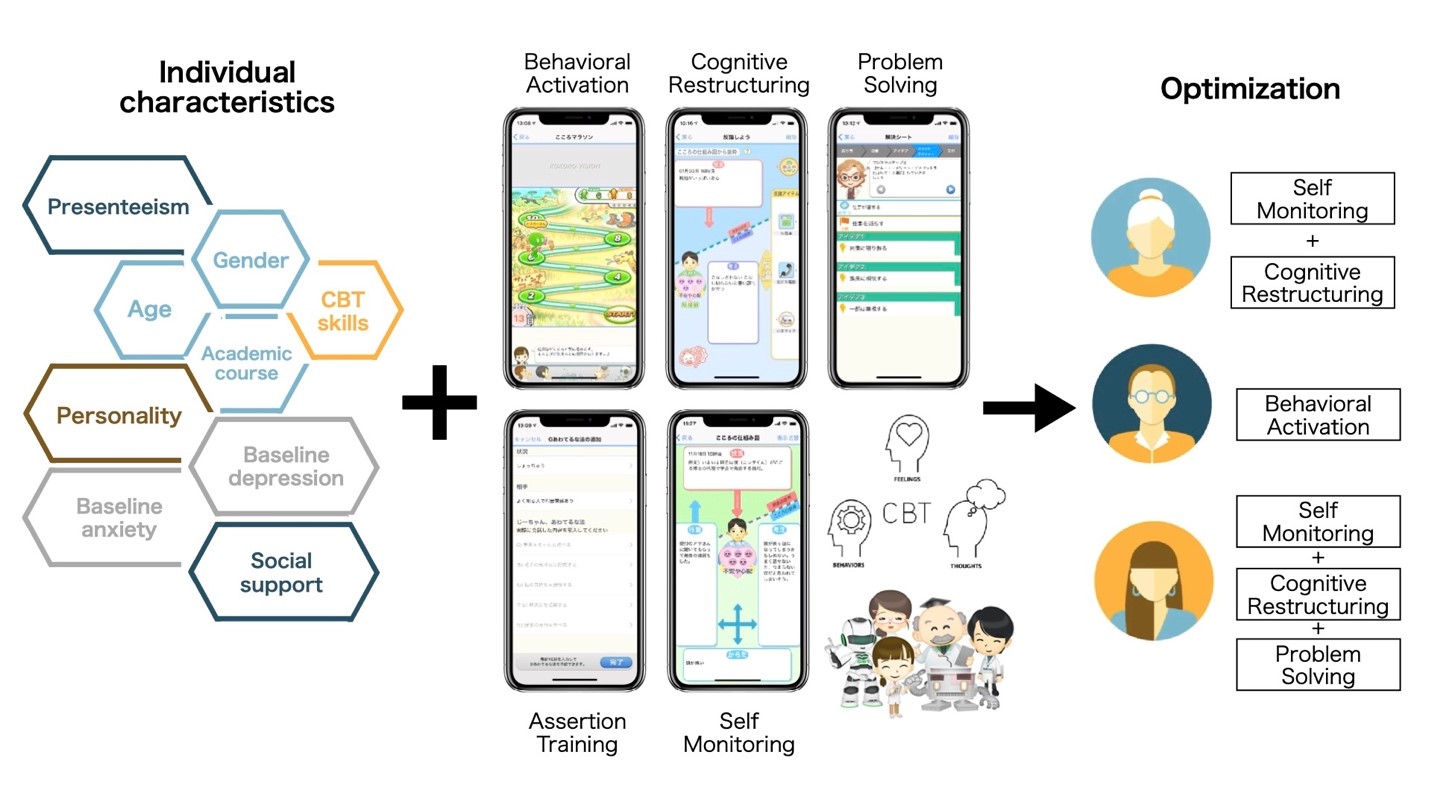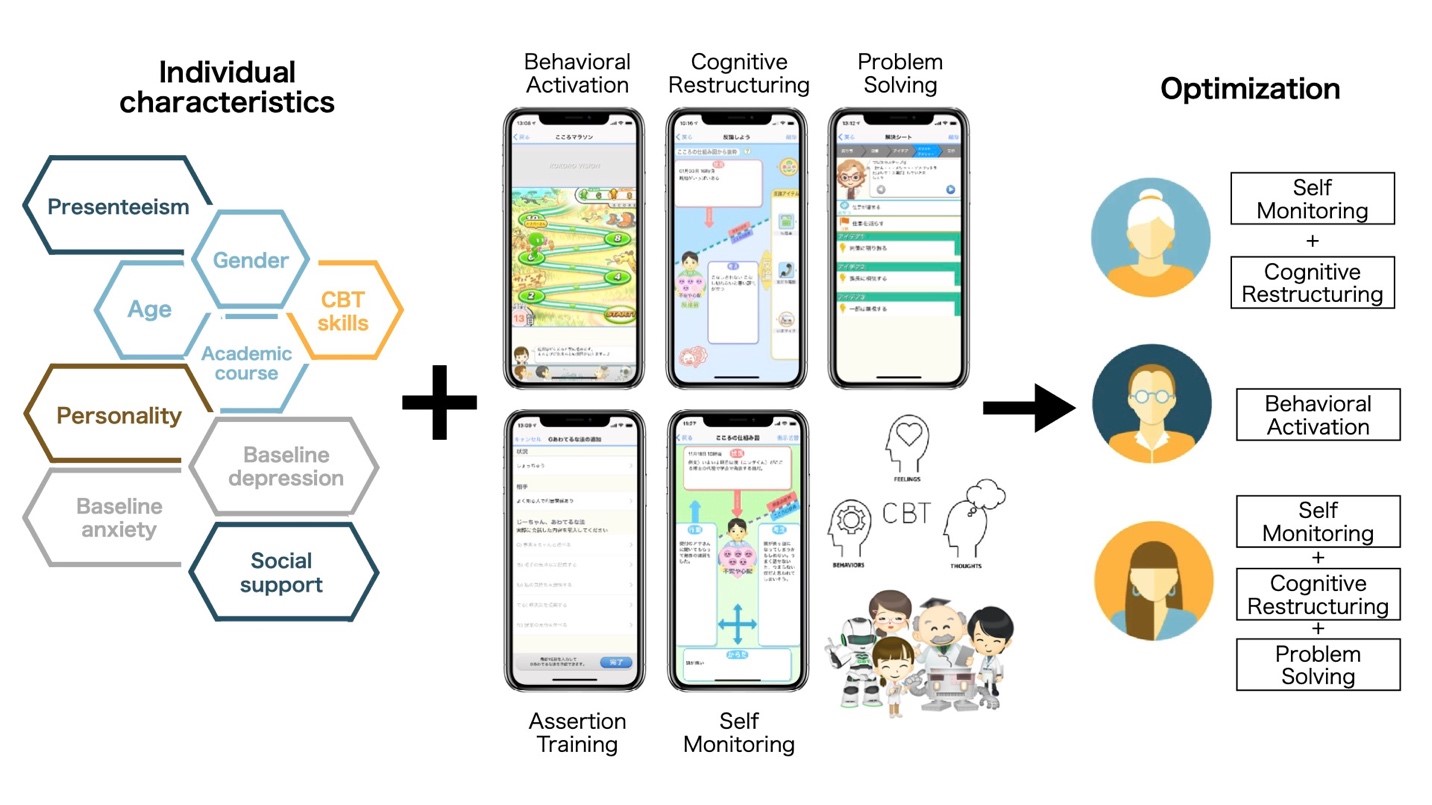
Mental Health and Psychosocial Support
for Health EDRM
Recent mental health & psychosocial support projects
Developing an algorithm for digital interventions to alleviate mental distress under the COVID-19 pandemic

Implementations
Implementing partners
Lead research institution:
Department of Health Promotion and Human Behavior, Kyoto University Graduate School of Medicine/ School of Public Health
Principal investigator: Professor Toshi A. Furukawa, MD, PhD
Location of research
Japan
Total budget
Background
Mental health problems among university students can lead to lowered academic performances, impaired social relationships, and subsequent development of more serious health and social problems. Universities have been adopting various strategies to help with distressed students, while facing challenges of limited face-to-face interventions. Under the COVID-19 pandemic, physical distancing policies to prevent infection may have exacerbated social isolation especially among young populations, including university students.
Under these circumstances, online-based therapeutic or preventive measures for mental health issues has been highlighted, due to accessibility and lower cost. The effectiveness of such internet cognitive-behavioral therapy (CBT) programs to alleviate depressive and anxiety symptoms has been supported by accumulating evidence1,2. In order to further maximize the impact of the therapy, it needs to be tailored to individual needs and characteristics.
To address this challenge, Kyoto University implemented the “Healthy Campus Trial” from 2018 to 2021. It was a multi-center, randomized, fully factorial trial, designed to examine and optimize the efficacy of five CBT components delivered by a smartphone app. In total 64 combinations of the five treatment components were delivered to 1,093 participants recruited from five universities in Kansai and Chubu Region, Japan. The primary analysis aimed to examine the average short-term effect among all the recruited participants. Findings suggested that depressive symptoms were significantly reduced for all participants after 8 weeks, although we failed to identify any particular components or their combinations that were superior than others in general. The long-term effect of depression prevention remains unclear. Furthermore, even though the average effects of these CBT components were similar, individuals might have differential responses. Therefore, further secondary analyses such as developing an algorithm that can optimize the treatment based on individual characteristics are warranted.
References
- Cuijpers, P., et al. (2019). Effectiveness and acceptability of cognitive behavior therapy delivery formats in adults with depression: A network meta-analysis. JAMA Psychiatry 76(7): 700-707.
- Karyotaki, E., et al. (2021). Internet-based cognitive behavioral therapy for depression: An individual patient data network meta-analysis. JAMA Psychiatry 78(4): 361-371.
Goals and objectives
- Investigate the long-term depression prevention effect of the digital mental health intervention.
- Generate evidence-based, individualized strategies that can efficiently deliver optimal digital mental health intervention components, in order to maximize young people’s mental health under the COVID-19 pandemic.
Methods
Secondary analyses on the established data from the Healthy Campus Trial are to be conducted. In this trial, 1,093 participants were recruited from five universities between September 2018 to May 2021. They were randomized to receive 64 different combinations of five CBT components delivered by smartphone app, which aimed to alleviate depressive symptoms. The baseline characteristics including demographics, personality, CBT skills, baseline depression and anxiety severity, presenteeism, etc. were collected. Then, depression and anxiety severity were assessed weekly until 8 weeks, and then every 4 weeks after that until 52 weeks.
The planned secondary analyses include:
- To examine the long-term effect of each single or combinations of multiple components on preventing depression within 52 weeks. The outcome is the incidence of depression, by Composite International Diagnostic Interview (CIDI). We will use two models: (1) a mixed-effect logistic regression model, where the outcome is treated as a binary variable at 52 weeks; and (2) a Cox proportional hazards model survival analysis, in which the time of depression occurrence will be reflected as well.
- To explore the interaction between the individual’s baseline characteristics and the short-term depressive and anxiety symptom alleviation effect of each CBT components and their combinations. The baseline characteristics include: demographics such as age, sex, academic course, life style, etc.; personality, cognitive and behavioral skills, presenteeism, social support and others. The interaction will be examined by including treatment-by-covariate interactions in a linear mixed-model. These interactions will help to identify the individual features that may benefit more from a specific CBT component.
- To use statistical and machine learning methods to build prediction models to predict the improvement in depressive and anxiety symptoms, given the patient characteristics, for certain CBT components and combinations. The basic model will be a linear mixed model, including baseline characteristics as prognostic factors, and component-by-covariate interaction terms for factors identified from analysis. We will also explore other machine learning modeling approaches.
Expected outputs from the research
- An algorithm to match smartphone CBT interventions with individual characteristics, so that each individual can benefit most efficiently and effectively from interventions that are matched to their individual needs. The algorithm will provide evidence-based guidance to local, national and international agencies as well as university authorities.
- Manuscripts for peer-reviewed journals and presentations for academic conferences
- A proposal of an optimized mental health intervention form for university students to university health administration and local government. The results to be disseminated through the network of university health administrations.
Results
For Objective (1): Investigate the long-term depression prevention effect of the digital mental health intervention:
The overall incidence of depression within one year, as determined by the computerized Composite International Diagnostic Interview
(CIDI), was 10.2% among the participants. Similar to the results of the short-term effect analysis, we could not identify any smartphone CBT components that were significantly better than others on average. The hazard ratio for each component was
between 0.843 to 1.259, none of which was found statistically significant. Our next step is to construct a prediction model that estimates the probability of developing depression within one year and the probable decrease in the incidence with different
combinations of smartphone CBT components, based on individual baseline characteristics.
For Objective (2): Generate evidence-based, individualized strategies that can efficiently deliver optimal digital mental health intervention
components, in order to maximize young people’s mental health under the COVID-19 pandemic:
To produce personalized treatment strategies for individual participants, we first attempted to classify university students with subthreshold depression
into several subtypes based on their CBT skills, before any treatments were given. A hierarchical clustering analysis categorized the students into three clusters: reflective low-skilled students, non-reflective high-skilled students, and non-reflective
low-skilled students. We observed that non-reflective low-skilled students had significantly higher levels of depression compared to the other two types. These findings suggest that digital mental health interventions for university students may need
to be tailored to their CBT skills profiles.
As mentioned in the Methods section, we utilized two distinctive approaches to generate individualized evidence for optimizing the alleviation of depressive symptoms among university students
using a smartphone CBT app. The first approach involved examining treatment-by-covariate interactions between personal baseline characteristics and the short-term effect of CBT components, using a mixed-effects model for repeated measures. Findings
indicated that higher PHQ-9 scores at baseline corresponded to greater symptom reduction after 8 weeks, while more frequent exercise habits correlated with reduced effectiveness of the self-monitoring component.
Our second approach
involved using a novel 2-stage statistical algorithm to create a model that predicts PHQ-9 scores at 8 weeks after treatment with different CBT components for individuals based on their baseline characteristics. Overall, even without other CBT components,
weekly self-checks of the PHQ-9 alone substantially reduced depression. With the model, we can predict the degree of improvement for different combinations of components more accurately. We made an R Shiny web application to provide interactive visualization
of these predictions. The web app can help participant understand the scientific evidence and facilitate efficient decision-making when selecting optimal CBT components.
In addition, we also analysed the characteristics of participants
that were related to their adherence to the CBT components. Overall, we found that the adherence was high (82-91% depending on the component). The analysis showed that participants who scored high on the personality trait of conscientiousness and
those who were female were more likely to complete the components of the digital CBT program.
Additional analysis:
Although our primary interest was optimizing the digital interventions to improve university students’ mental
distress during the COVID-19 pandemic, our trial began recruitment before the pandemic. This allowed us to analyse the impact of the pandemic, specifically the state of emergency declaration, on students’ mental status using the interrupted
time series analysis. The results suggested that students’ stress tended to increase with the start of a new semester regardless of the state of emergency declaration, and the declaration did not significantly impact the students’ mental
health.
Global implication
This will be the first individualized optimization algorithm for digital CBT components in improving depressive symptoms for university students. Although the proposed prediction model per se may need further external validation in order to be disseminated outside Japan, the methodology we use can be generalized globally when approaching such precision medicine goals. The baseline features that are revealed to be interacted with the intervention may shed lights on future trial designs in academic world, and may influence decision-making in public health and clinical practice regarding university students’ mental health.
Local implication
As the prediction model is built on a large-scale randomized trial in Japan, we plan to propose the findings and the individualized intervention optimization algorithm to Japanese universities and local government directly. We expect it can help the university health administrations successfully deliver the optimal interventions to students who need it based on the best evidence.
Publications
- Sakata M, Toyomoto R, Yoshida K, Luo Y, Nakagami Y, Uwatoko T, Shimamoto T, Tajika A, Suga H, Ito H, Sumi M, Muto T, Ito M, Ichikawa H, Ikegawa M, Shiraishi N, Watanabe T, Sahker E, Ogawa Y, Hollon SD, Collins LM, Watkins ER, Wason J, Noma H, Horikoshi M, Iwami T, Furukawa TA. Components of smartphone cognitive-behavioural therapy for subthreshold depression among 1093 university students: a factorial trial. Evidence Based Mental Health 2022; 25:e18-e25. [IF=13.5]
- Toyomoto R, Sakata M, Yoshida K, Luo Y, Nakagami Y, Uwatoko T, Shimamoto T, Sahker E, Tajika A, Suga H, Ito H, Sumi M, Muto T, Ito M, Ichikawa H, Ikegawa M, Shiraishi N, Watanabe T, Watkins ER, Noma H, Horikoshi M, Iwami T, Furukawa TA. Prognostic factors and effect modifiers for personalisation of internet-based cognitive behavioural therapy among university students with subthreshold depression: A secondary analysis of a factorial trial. Journal of Affective Disorders 2023; 322:156-62. [IF=6.8]
- Toyomoto R, Sakata M, Yoshida K, Luo Y, Nakagami Y, Iwami T, Aoki S, Irie T, Sakano Y, Suga H, Sumi M, Ichikawa H, Watanabe T, Tajika A, Uwatoko T, Sahker E, Furukawa TA. Validation of the Japanese Big Five Scale Short Form in a university student sample. Frontiers in Psychology 2022; 13:862646. [IF=4.2]
- Shiraishi N, Sakata M, Toyomoto R, Yoshida K, Luo Y, Nakagami Y, Tajika A, Suga H, Ito H, Sumi M, Muto T, Ichikawa H, Ikegawa M, Watanabe T, Sahker E, Uwatoko T, Noma H, Horikoshi M, Iwami T, Furukawa TA. Three types of university students with subthreshold depression characterized by distinctive cognitive behavioral skills. Cogn Behav Ther. 2024 Mar;53(2):207-219. doi: 10.1080/16506073.2023.2288557. Epub 2023 Nov 27. PMID: 38008940. (Published online 27 November 2023)
- Shiraishi N, Sakata M, Toyomoto R. Yoshida K, Luo Y, Nakagami Y, Tajika A, Watanabe T, Sahker E, Uwatoko T, Shimamoto T, Iwami T, Furukawa TA. (2023). Dynamics of depressive states among university students in Japan during the COVID-19 pandemic: an interrupted time series analysis. Ann Gen Psychiatry 22, 38. https://doi.org/10.1186/s12991-023-00468-9 (Published online 10 October 2023)
- Nakagami Y, Uwatoko T, Shimamoto T, Sakata M, Toyomoto R, Yoshida K, Luo Y, Shiraishi N, Tajika A, Sahker E, Horikoshi M, Noma H, Iwami T, Furukawa TA. Long-Term Effects of Internet-Based Cognitive Behavioral Therapy on Depression Prevention Among University Students: Randomized Controlled Factorial Trial. JMIR Ment Health 2024;11:e56691 doi: 10.2196/56691 PMID: 39319584

